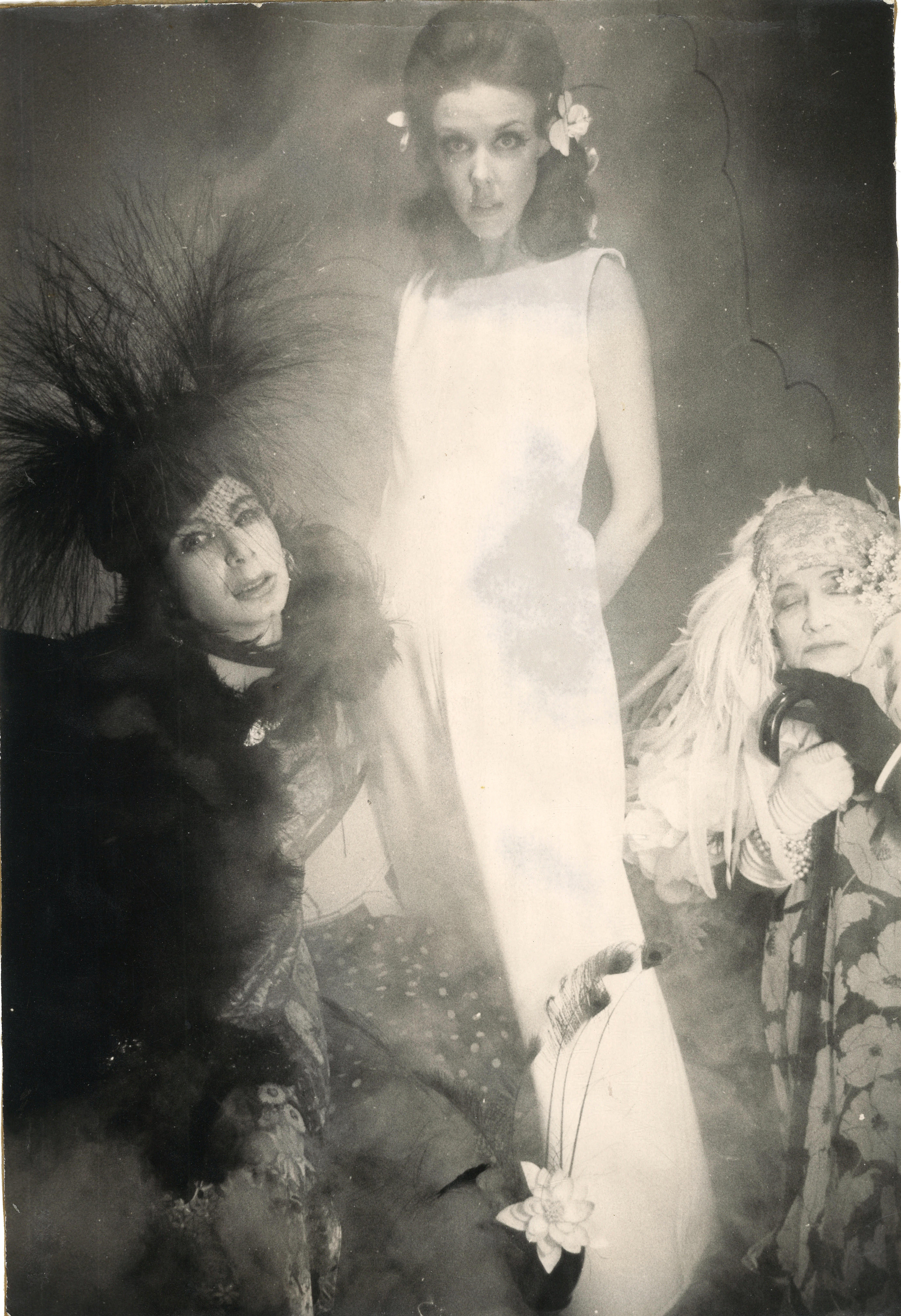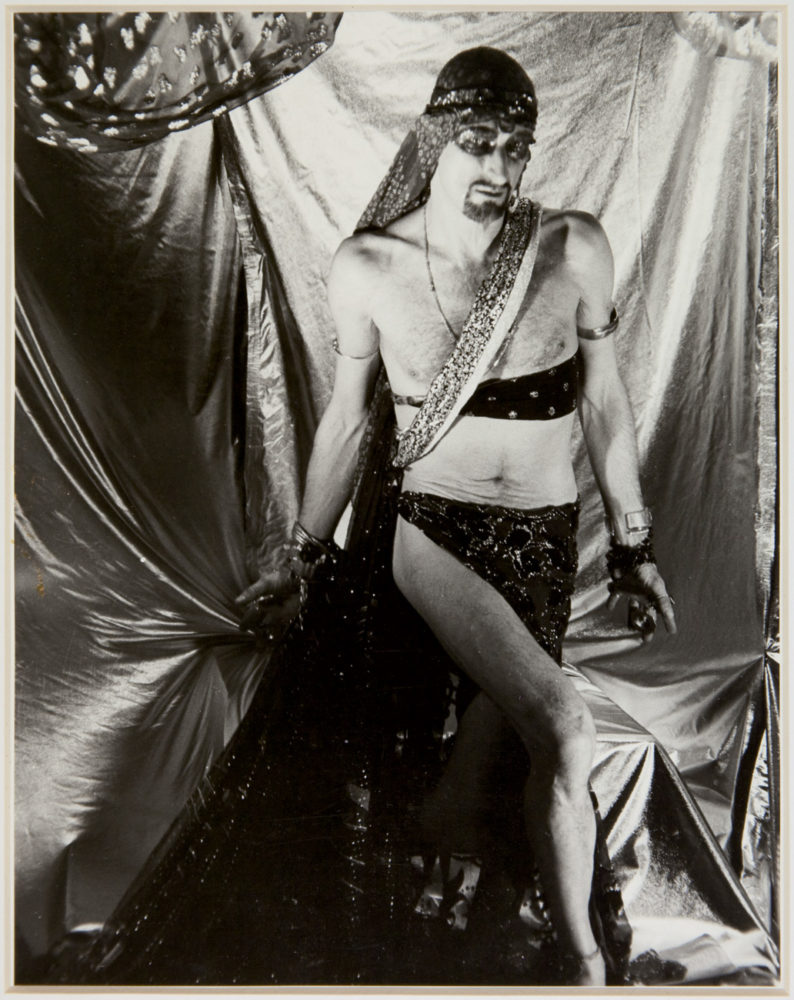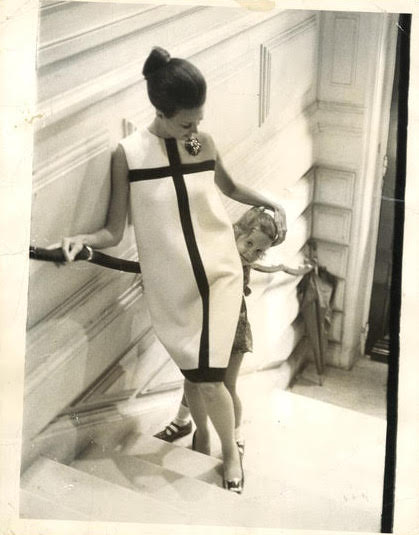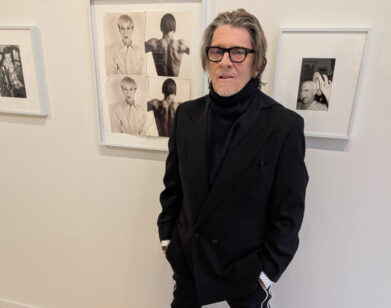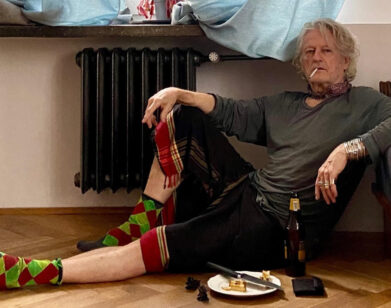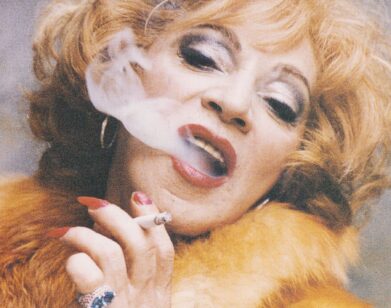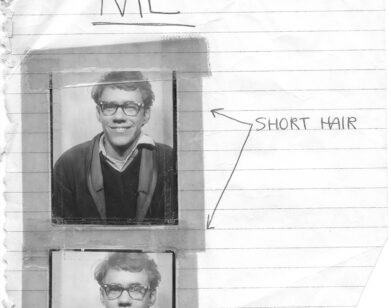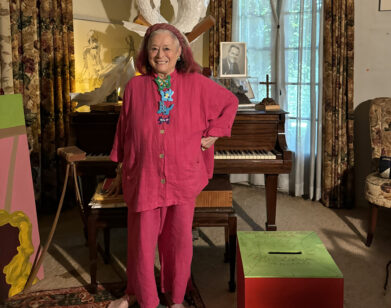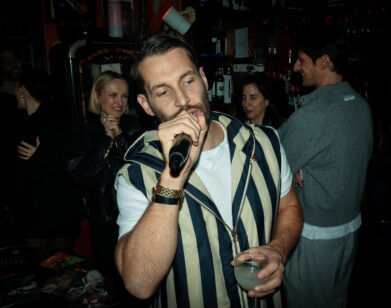NOSTALGIA
Writer Fernanda Eberstadt on Growing Up at Warhol’s Factory
———
STEPHANIE LACAVA: Hi.
FERNANDA EBERSTADT: Hi, Stephanie.
LACAVA: How are you?
EBERSTADT: Great.
LACAVA: What are the pictures behind you?
EBERSTADT: They’re clouds. This is actually an apartment I’ve rented for the month. It’s fantastic. It’s one of the nicest apartments I’ve ever lived in.
LACAVA: Oh, I love that. Speaking of photographs, we should jump right into it. I saw a photo this morning of your mom with Lou Reed at one of Andy Warhol’s birthday dinners. Do you know the one I’m talking about?
EBERSTADT: No, I don’t.
LACAVA: I was doing a little looking around and I saw it and thought it was a good place to start, if only because of Interview Magazine.
EBERSTADT: Is it just my mother and Andy Warhol together?
LACAVA: There’s a couple people. Jay Mellon was there.
EBERSTADT: Oh, I’d love to see it.
LACAVA: I’ll send it to you.
EBERSTADT: The first pieces I ever published in my life were at Interview Magazine.
LACAVA: Really? I didn’t know that.
EBERSTADT: Yeah. I worked there when I was 16 years old. I did a bunch of pieces in that magazine, an interview with Bruce Chatwin, with the choreographer Lucinda Childs, with Andy deGroat, who is a fantastic choreographer who doesn’t work much anymore. He got sick. At that age I was obsessed with [George] Balanchine.
LACAVA: Oh, me too.
EBERSTADT: I worked backstage at the New York City Ballet and I answered the phone on weekends.
LACAVA: And Suzanne Farrell was there?
EBERSTADT: Yes. Was she ever. She had just come back from Béjart [the dance company of choreographer Maurice Béjart, in Brussels].
LACAVA: Oh my god.
EBERSTADT: It was her comeback. She was sent into exile when she got married and broke Balanchine’s heart. I got permanent free tickets in exchange for working there, and I went three times a week or something.
LACAVA: You danced?
EBERSTADT: No, I watched. I answered the telephone. And I didn’t write about it in the book, but I worked at the factory when I was 16 years old. Bob Colacello, who was the editor then, was my first boss. It was a summer job.
LACAVA: So this is perfect.
EBERSTADT: It’s a real homecoming, yeah.
LACAVA: Well I want to go in both directions with the questions, because there’s a lot of stuff that’s fun and glamorous, but there’s a lot of serious stuff. I’ve been writing a lot of criticism that takes [Pier Paolo] Pasolini as the launching point. When I read your book, it blew my mind because we were both thinking the same. I’ve been approaching art criticism through his lens as a way of talking about other systemic things, and I was blown away when I got to the final chapter because he’s one of your touchstones, too.
EBERSTADT: He sure is. He’s so key to everything.
LACAVA: Everything. But I wanted to start with Jack Smith‘s stuff. Because it sets up a nice parallel to your relationship with Stephen [Varble], right?
EBERSTADT: Oh, wow. That’s so sharp of you.
LACAVA: Maybe it was, in some ways, a subconscious recreation of your mother’s relationship that you saw.
EBERSTADT: It totally was. That is very perceptive. Should I do a little bit of explanation of who they are?
LACAVA: Yeah.
EBERSTADT: So, first of all, some stuff that went in the [Galerie] Buchholz show came from my collection, which I inherited from my parents. Jack Smith was this unbelievably outrageous, underground filmmaker who filmed these wild characters. He was recreating crazy, camp, kitschy, ’30s movies in his own way, but on expired film stacks, so the color is all weird. He had such bizarre, sugar-coated, hallucinogenic fantasies, and they were these orgiastic love scenes of polyamory and wild music. Every single person in his movies is either a drag queen or a woman imitating a ’30s B-movie starlet. He and my mother were great friends. Like him, my mother came from Baltimore, and she was longing to get to New York and meet people who were eccentric freaks, loners and dreamers. She and my father got together when she was 21, and together they were exploring the underground ’60s, or even late ’50s, art scene. And she met Jack Smith, who was a really big love of hers. He was somebody who was so demanding artistically and had such a hot temper. He fell out with everybody, so they feuded a lot. He would stop speaking to her. He had a famous saying which was, “I want you to obey my unspoken thought command.”
LACAVA: Obviously.
EBERSTADT: Obviously. So she felt a little overwhelmed by his demand that she could never give enough. He wanted constant emotional and material support to make his dreams come true. When I was a little kid, I was supposed to be in a play of his. I was supposed to play a pirate girl, and swing on some rope across the–
LACAVA: Very Kathy Acker.
EBERSTADT: Yes. Strangely enough, that didn’t come to fruition. The only time I ever remember my mother being on the subway was when me, her, and Jack Smith went to Rockaway Beach to film.
LACAVA: Oh, my god.
EBERSTADT: I was so obsessed with my mother growing up. I was very wrapped up in her. I felt like the ’60s were this magical time that I’d missed, when she was hanging out at Andy Warhol’s factory and being a muse to Jack Smith. It seemed like the coolest time imaginable. And I wanted to relive it and recreate it, so that was why I went and worked at Andy Warhol’s factory. When I was 14 my best friend was Stephen Varble, who I literally met on the street. He was from Kentucky and was a costume artist, drag queen and transvestite artist who made all of his costumes out of garbage. He was utterly impoverished. He kept on moving from one pretty rackety rental to another. He would make his costumes out of egg cartons and broken toys and gold labels from whiskey bottles. I’d been following him around, and then I spotted him performing during the Easter Parade on 5th Avenue. I was actually carrying a newspaper clipping with a photograph of him in a wallet when I saw him.
LACAVA: No way.
EBERSTADT: Yeah. I didn’t know him, I was just fascinated by him. When I saw him performing at the Easter Parade, he was arm-in-arm with this black leather S&M cowboy who was his soiree partner. I showed the newspaper clipping to the cowboy who passed it along to Stephen. I went back to their place straight from the Easter Parade. I was 14 years old! The cowboy showed it to Stephen and he lit up. He was doing all his silent movie pantomime and at a certain point, the crowd turned really nasty and started throwing soda cans at Stephen. There were policemen right there but they didn’t do anything. Online you can see a photograph of him at the Easter Parade, wearing the costume with this boyfriend.
LACAVA: I love that. Your friendship lasted longer than the Cowboy, huh?
EBERSTADT: Yeah, we lasted through the years. We survived a lot. He took me back to his place and then we all went out to dinner. It was the beginning of a wild friendship, and actually he made a video about the two of us, but nothing of his survived. There was a show at the Leslie Lohman Museum. There was this wonderful curator, an academic professor called David Getsy, who put on a Stephen Varble show. But all of his things were so ephemeral. The last costume that survived got swept away in Hurricane Sandy. It was stowed in somebody’s basement and it got flooded.
LACAVA: It seems like the universe did that on purpose.
EBERSTADT: Yeah. He was very much influenced by Jack Smith. For me, Stephen Varble was to me what Jack Smith had been to my mother.
LACAVA: I felt that in the text and the images I saw. I also felt very much in the book this idea of you writing to write out the fact that your mother couldn’t write. She became the muse instead of the artist.
EBERSTADT: It’s very powerful, that thing of a mother who’s blocked in some way. My mother had a lot of substance abuse issues and was depressed and sick. So it’s this motherly relationship where you’re having to take care of her and also she’s living things through you, and it becomes this intense identity-fusion thing where anger and love are very tightly bound together.
LACAVA: Did you ever feel that you wanted to divorce yourself from what your parents represented?
EBERSTADT: Yeah, really strongly. There was a big break. I always had it in my head that I wanted to go to college in England.
LACAVA: You did, right? You went to Oxford?
EBERSTADT: Yeah. From a very young age I really wanted to go to England. I felt my parents were so all embracing that they were all-consuming. When I was 17, I went to London, which they did not want me to do. You had to take special entrance exams to get into Oxford. So I went and lived in a series of boarding houses in London, and that was when I encountered a world where nobody had ever heard of my parents. So if somebody liked me, they liked me.
LACAVA: That’s healthy, too.
EBERSTADT: Yeah. That was such freedom. From then on, it felt like, “Okay, I’m me.” It’s not just because of family connections, anything I make, anything I get, anything that happens to me.
LACAVA: Right. That’s interesting because it draws back to your interest in Pasolini and some of the dualities that he inhabits, being this great Italian son who had some reactionary and radical beliefs, and how he navigated that and what that meant.
EBERSTADT: Yeah. I identified with how bound up in his mother he was, and how he described her love.
LACAVA: One other thing I wanted to bring up before I forget is the Arthur Jafa story. I want to hear that in your words, because it stood out to me.
EBERSTADT: Yeah. For me, they’re these two intertwined fairytales. I am a huge Arthur Jafa fan. I love his films. And this came from a lecture I saw on YouTube. He tells the story of the origins of the Griya. It’s about two brothers who go off to find their fortune, and they are broke and destroyed. They’re coming home impoverished, sick, beaten up, and one of them can’t go any farther. He’s dying. He drops in the ditch and says, “You go ahead. You get back there, you get back home without me. I’ll be fine. One of us should make it.” So the stronger brother goes ahead. He goes like, a quarter of a mile and he thinks, “God, I can’t let my brother die.” So he takes a knife and he chops off a big chunk of his calf and limps back to his brother, who’s almost dead. And he says, “Look, I’ve got some food.” And he makes a fire and he cooks this big chunk of his calf, and he feeds it to his brother. His brother gets stronger and they make it back to their home village. And everybody’s celebrating and rejoicing. Then all of a sudden, they see the older brother’s mutilated calf and this big chunk of blood. The younger brother says, “You fed me your own flesh to keep me alive. From now on, I will spend the rest of my life telling the story, glorifying you, singing your praises, and my children will glorify your children.”
LACAVA: That is so potent in regards to the book. One, because you are telling the story of your family through these stories of other cannibals. Also, it’s fun to mention that the title is Bite Your Friends from the–
EBERSTADT: Whoa. I hadn’t thought of that.
LACAVA: It stuck out to me because I have a seven-year-old who just started to read and he saw your book and he loved it. He came up to me and started nibbling on my shoulder. I was like, “What are you doing?” He’s like, “Your book says bite your friends.”
EBERSTADT: That’s so cute.
LACAVA: That’s when it struck me that it was full circle.
EBERSTADT: I totally didn’t connect that. The title actually comes from Diogenes, who’s the cynic philosopher, and cynic means dog, because he lived like a dog. He says, “I bite my friend’s to cure them, meaning I’m like a rabid, mad dog. But instead of killing people, my bite brings them back to life.” But I hadn’t made that connection with the Arthur Jafa story.
LACAVA: Have you read Robert Gluck’s Margery Kempe?
EBERSTADT: No, I haven’t.
LACAVA: It’s Robert Gluck intertwining the story of the Christian Mystic with one of his own romantic obsessions. It’s also about a saint, and there are a lot of similarities I found looking at your book through that lens, because you talk about the martyr and the saint. Do you want to talk a little bit about McCreen, Perpetua, the other saints that pop up?
EBERSTADT: Yeah. There’s this big saint theme in the book because that was how the concept started in my head, the idea that these saints performed. Their acts were quite similar to conceptual artists today. Mostly, I write about Saint Perpetua, who’s this fourth century Carthaginian saint martyr. She wrote this prison diary and it survives. It’s so unreal. It ends the day before she’s sacrificed to wild beasts in the amphitheater at Carthage. So she writes about everything leading up to then, and about this crazy dream she had where she strips naked and becomes a man in the amphitheater and she’s fighting this Egyptian gladiator. What interested me was, she was 21 years old and had a baby who she was nursing, so she writes about nursing and her engorged breasts. She writes about her physicality in a very honest and simple way. She and her buddies refused to sacrifice the Roman Gods, and that’s why they were executed and fed to the wild beasts before this jeering mob of 50,000 people.
LACAVA: That’s interesting, because she [Margery Kempe] wrote this autobiographical prison diary. It reminds me of you guys all working together to tell these stories.
EBERSTADT: There’s fascinating stuff to be done back and forth.
LACAVA: The other thing I wanted to talk about was Henry Darger, because that scroll is so important and it makes sense that you reference it in the book.
EBERSTADT: Yeah. He was the most outsider artist of any artist, and his stuff is so beautiful. He lived in Chicago. Was he actually a janitor?
LACAVA: Yeah.
EBERSTADT: And he, for 40 years or something, produced this 3,000 page book, The Story of the Vivian Girls.
LACAVA: Yes. Were they intersex, some of the drawings?
EBERSTADT: Yeah. They were little girls with penises, and everyone speculated about why. Some people think he didn’t know what naked women looked like, so he just assumed they looked like men.
LACAVA: Oh, my god. Wow.
EBERSTADT: That seems a little far-fetched. I think he just had a wild imagination. It was very Christian and very intergalactic. It’s text alongside these wild comic book drawings in these candy colors.
LACAVA: Which links back to the Jack Smith description you gave us at the beginning.
EBERSTADT: Yes. But Henry Darger was kind of pre-sexual, post-sexual, intersexual, polysexual. But he also got into such an extreme of kitschiness that it almost became unsexual, too.
LACAVA: I love that. I’m also interested in how you were worried about how the book would be received, and how you thought it was strange, but it seems so not strange to me, in a way.
EBERSTADT: Oh, good. Well, then you’re my ideal reader.
LACAVA: This is really a book about a parent-child relationship.
EBERSTADT: Yeah, very much. That is a strong strand of it. No matter what I’m writing about, I’m always writing about family.
LACAVA: How would you define family?
EBERSTADT: Family is your people. That’s why I’m always drawn to artists who find their chosen people, their other. Pasolini found his people. They all did. Stephen Varble found his people, fellow transvestite artists and underground photographers. We’re all looking for our people. A lot of people come to New York to find their people.

